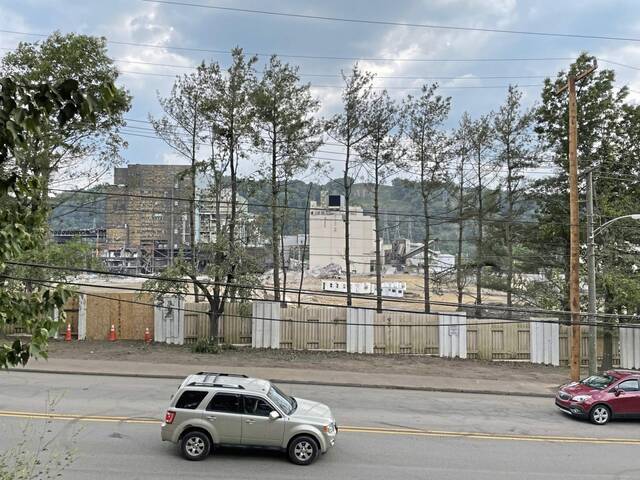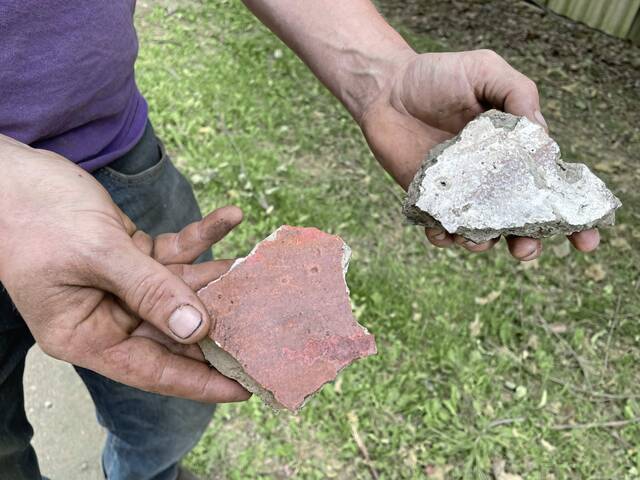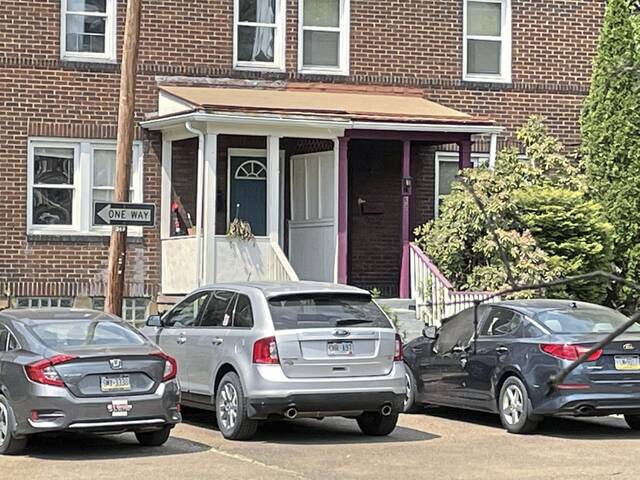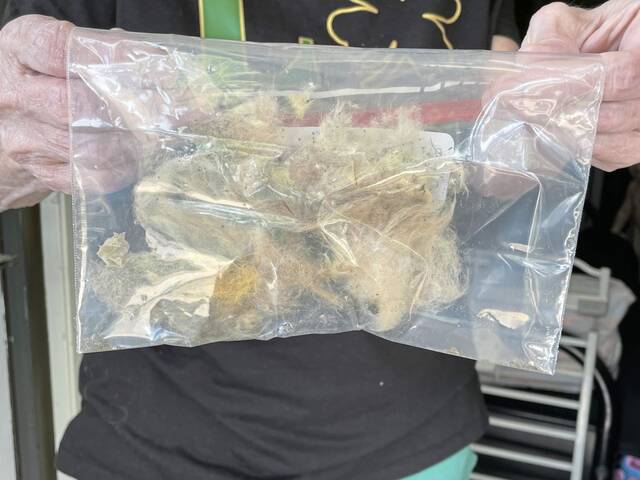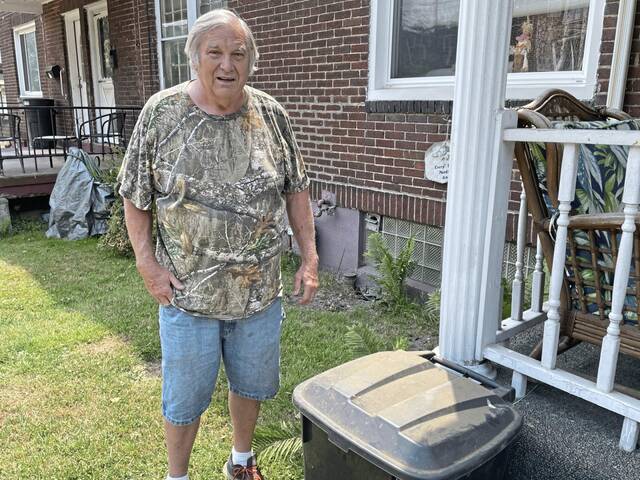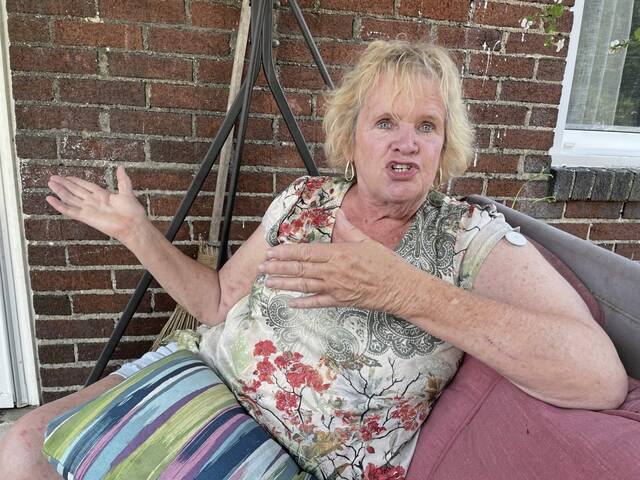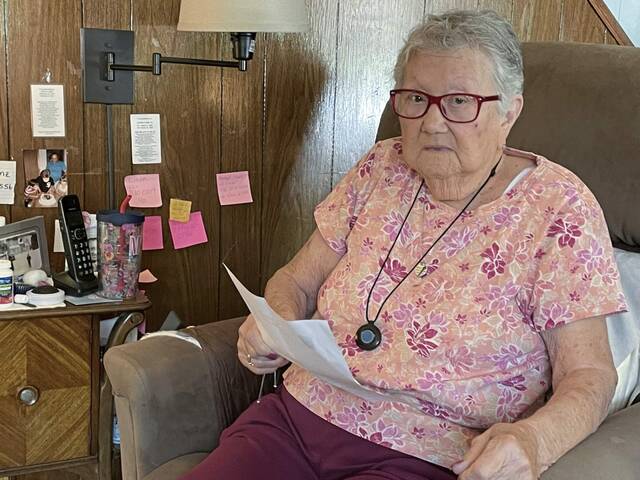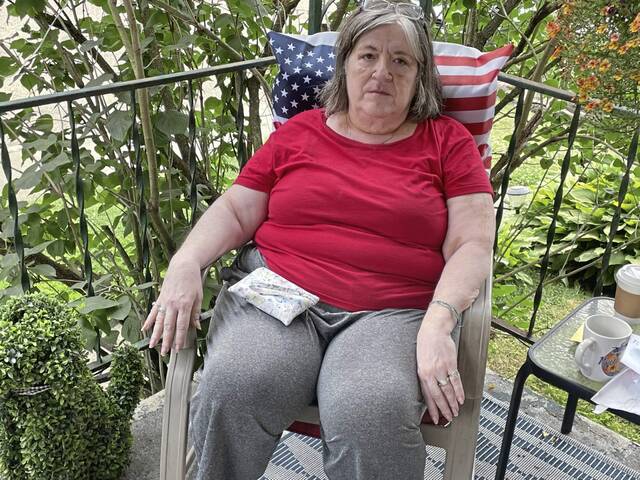Amid dusty cleanup, Springdale residents remain unsettled in the wake of smokestack implosions
Susan Mangel didn’t mince words about the implosion Friday of the two towering and iconic smokestacks that have dominated Springdale’s skyline for decades.
“It was a disaster,” declared the 22-year resident of Duquesne Court, heaving a sigh from her perch on a porch swing as she gently rocked Saturday in the swelter.
Dust on her stoop. Dust in her covered hot tub. Dust on the lawn, the flowers, the trees. Dust, thick and brown, coating the porch roofs up and down the street.
You had to look no further than Mangel’s front stoop, where several neighbors gathered Saturday afternoon, to find people who were hot and bothered by the fallout from the controlled demolition of the old Cheswick Generating Station’s stacks.
“It wasn’t supposed to come over this way,” Mangel, 70, said of the dust cloud. “We were sitting here watching it. All of a sudden you couldn’t see anything. Everything was covered.”
The blast used explosives to bring down the stacks in a one-two-punch fashion, the larger one toppling over like a felled Sequoia, a dust trail streaming from it like the tail of a comet.
Tumbling into a cleared coal yard along the Allegheny River, the giant smokestacks raised a gargantuan dust cloud that barrelled across Pittsburgh Street, engulfing the low-slung homes in the area and depositing an unwelcome patina on all surfaces.
Joe Kern shot video of the thick, blossoming cloud from the roof of his building on the corner of Duquesne Court and Pittsburgh Street. It looked like a sandstorm churning across the Sahara.
He wore a respirator. But a day after taking the video, Kern was complaining of swollen eyes, an itchy back and breathing problems.
Was it the dust? He didn’t know. His wife, Caitlin, said she was worried about her young children playing in the grass outside.
As Mangel described her irritation with the implosion’s aftermath, her neighbor, Linda Schafer, ambled over from across the street. Mangel called out to ask how she was doing.
“Lousy,” Schafer shot back. “Basically, we were lied to.”
Plopping down on a chair, Schafer rattled off her aggravations.
She said Springdale’s mayor had assured folks on the street a week earlier that there wouldn’t be anything to worry about after 11 a.m. Friday, three hours after the demolition.
“The mayor and the police officer came around and said there should be no harm,” Schafer said. “After that, you’ll be fine.”
But Schafer, like other residents on the tight-knit street, isn’t so sure that’s accurate.
“I don’t feel safe,” Schafer said. “As far as I’m concerned, the clean-up wasn’t proper. That’s another thing we were told — everything would be clean and back to normal.”
Schafer has health concerns. She’s taking dirt samples that she hopes to have analyzed. And she’s already putting together a mental list of elected officials and offices to contact.
“I plan on calling the EPA,” said Schafer, 64. “If I have to, I’ll go to the White House.”
More on the Springdale smokestack implosions:
• Springdale smokestacks come down but take down power lines; some home damage reported
• Photo gallery: Cheswick Generating Station’s smokestacks come down
• Watch: Springdale smokestacks come down
• What to know about the implosions of the Cheswick Generating Station smokestacks
Despite the borough employees and contract workers who rolled through the neighborhood, deploying leaf blowers, a street sweeper and even gloved men who got down on their knees and used their hands to collect dust in garbage bags, particles still soiled yards and buildings.
Tufts of what looked like pale-yellow insulation were all over the neighborhood, on walkways, atop hedges, on patio steps.
Using a paper towel, Pam Stanley picked some up ever so carefully and sealed the sample in a baggie for possible testing.
“It was all over the backyard,” said Stanley, 70, whose home fronts Pittsburgh Street across from the old power plant. “My son said it looked like it snowed out here.”
Stanley pointed to brown dust soiling children’s toys and a white, square plastic table on her back stoop where her grandchildren sometimes eat.
Not any more.
“My daughter says she’s going to get rid of these things,” Stanley said.
Although officials have said there was no asbestos in the old stacks, which measured about 750 feet and 552 feet tall, there was plenty of skepticism to go around in Springdale. Residents were not keen to take authorities’ statements at face value.
The mayor responds
Springdale Mayor Joe Bertoline sympathized with residents, but he said he was “confident” that there was no asbestos. He said the material covering parts of his borough was fiberglass insulation along with coal dust and gypsum.
The mayor said the dust was about what he expected, and the forecast was for the particles to churn across Pittsburgh Street.
Bertoline said that the demolition company, Controlled Demolition Inc., and the general contractor, Grant Mackay Co., sketched out precisely how the smokestacks would fall.
“If you could have put a dime on the spot where they wanted it to come down, it would have come down on that dime,” the mayor said. “It fell precisely where they wanted it to — both stacks.”
The one thing no one counted on, Bertoline said: the rush of air from the stacks that smashed into a line of trees, knocking them into power lines and buckling telephone poles.
“That,” Bertoline said, “was a major hiccup.”
When reached Saturday evening, Allegheny Valley Emergency Management Coordinator Bruno Moretti said he was too busy to talk.
Representatives from Charah Solutions, the property owner, and Grant Mackay, could not be reached for comment Saturday.
Beyond the dirt and debris that irked people, there were other vexations.
Springdale residents caught in the dust zone were forced to expend time and effort hosing down their properties and cleaning, recleaning and cleaning yet again.
Still, the dust remained, stubbornly sticking to the lid of Jacqueline Liotta’s black garbage can in her front yard down the street from Mangel. Her friend, Henry Pecher, who was walking a white chihuahua named Taco Bell, said the lid remained dirty despite scouring it.
“I think they should take the dust and take samples to a testing lab and see what’s involved,” said Pecher, 73, of Allison Park. “I don’t know if there’s something dangerous, but there’s enough of it around, people should know.”
Pecher worked in construction and said he performed lead inspections. He questioned why fire hoses weren’t trotted out immediately to wet the streets. Others questioned why the property owner didn’t wait for a rainy day or at least a day that wasn’t hot and sunny.
Not only were neighbors forced to put sweat equity into trying to return their homes to a pre-implosion state, some are also out money.
Schafer and her family, for instance, fled their homes and holed up at a Holiday Inn Express to avoid any problems.
Two rooms for two nights left Schafer $320 poorer. She’s saving all her receipts, from the room to a can of pop.
Others see an upside
Difficulties from the implosion’s aftermath aside, not everyone was dismayed by the change to Springdale’s skyline.
Bebe Szalai, another friend of Mangel’s, is a member of the Sierra Club. She was thrilled when the plant ceased operations in April 2022 after running for more than 50 years. For years, a layer of gray soot settled on any surfaces of her house untouched by rain.
The implosion was the dusty icing on the cake for her.
“We consider it a success,” said Szalai, 86, who lives on Grant Street. “There are individual concerns, and I have them, too. But all in all, we’re grateful to have this closed down.”
Liotta, also 86, watched as the sky darkened shortly after 8 a.m. Friday although it was a sunny day with blue skies.
“It got dark, like it was night,” Liotta said. “I was glad I had my lights on.”
Liotta, who has been in her house for 61 years, had forgotten all about the implosion. The flyer from the Springdale Police Department remained neatly folded and tucked in her purse. On Friday morning she was sitting in her brown recliner, feet on the ground, when she heard a sound like a bomb going off.
“When that implosion happened, my house shook and scared the daylights out of me,” she said. “But nothing broke. All my knickknacks and shelf stayed just like they were.”
Down the block, Paula Beattie praised local officials and the power company for the cleanup. Although the implosion led to some utility pole damage and knocked out power temporarily for some in the neighborhood, Beattie was happy that her apartment suffered no damage even though it was right across from the blast zone.
“It looked like Mad Max Thunderdome,” Beattie said, referring to the cult favorite post-apocalyptic movies which take place in a barren landscape.
She attributed her luck to a higher power. Beattie, 56, said she dabbed anointing oil on her front door, with a cross affixed to it, before the implosion.
Across the street from Beattie, Darius Obringer, 24, of Sarver took his time walking along the old plant’s fence line, peering through the slats and documenting the moment on his phone. In his hands he held two chunks of concrete, one red, the other white, that he had salvaged from the road. He’s sure they’re from the smokestacks.
Obringer planned to give them to a friend, a Springdale native, as a keepsake from a historic moment in borough history.
Jonathan D. Silver is a TribLive news editor. A New York City native and graduate of Cornell University, he spent 26 years at the Pittsburgh Post-Gazette as a reporter and editor before joining the Trib in 2022 as an enterprise reporter. Jon has also worked as a journalist in Venezuela, England, Wisconsin and California. He can be reached at jsilver@triblive.com.
Remove the ads from your TribLIVE reading experience but still support the journalists who create the content with TribLIVE Ad-Free.

